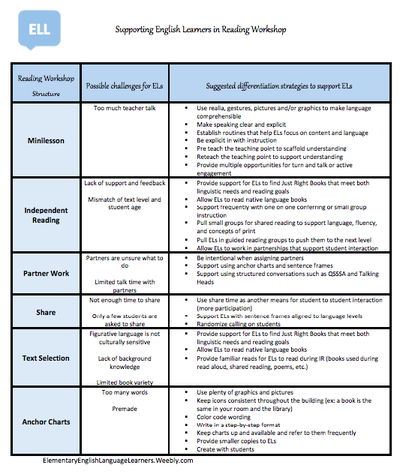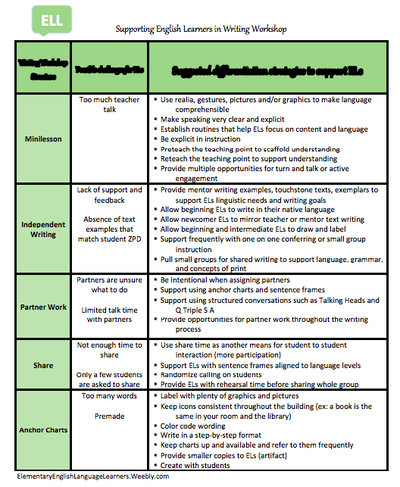|
This is a post I wrote for Tan's Blog. It was shared on EmpoweringELLs in May 2017. When I stop to reflect on what is BEST practice for my elementary ELLs in reading, writing, listening, and speaking, the answer comes to me quite clearly…the workshop model. Why? What I know about the needs of my ELLs is that they require explicit instruction, modeling, guidance, routine, and practice. Here’s how the reading and writing workshop models promote progress for ELLs in listening, speaking, reading and writing. The reading and writing workshops follow a specific daily routine. There is a structure to the workshop that is followed in order for each component to happen daily. The routine helps all students know what to expect. This is especially great for ELLs since they are (possibly) navigating a new language, school system, and culture. The Mini-lesson One of the components of both the reading and writing workshop is the mini-lesson. During the mini-lesson, the teacher gives direct instruction and explicitly shares with students what will be expected of them as readers and/or writers. ELLs need to know exactly what is expected of them as readers, writers and speakers. Since the mini-lesson is short, there is not a lot of teacher talk. One way to make the mini-lesson even more ELL friendly is to slow down speech and stop for a structured turn and talk. During this portion of workshop, ELLs are practicing listening and some speaking as well. Anchor charts are a key piece of the mini-lesson. This is how the teacher leaves a fingerprint of the teaching. The anchor chart should be able to support students as they go into independent work. It allows the teacher to work with small groups or confer one-on-one with students without being constantly interrupted by students who need re-teaching. For this reason, the anchor chart should be comprehensible for students. Limit the text and support the text with visuals and graphics. The anchor chart should give students clear, step-by-step guidance for their work. Independent Work The biggest piece of the reading and writing workshops is independent reading/writing time. During this block of time, students work on their own reading and/or writing. During reading workshop students are reading self-selected books at their reading level. Selecting books can be tricky. I don’t want my ELLs to feel bad if their reading level is way below their grade level in English. It can be hard to find texts that they can read but are still relevant and interesting to them. Adapted texts and nonfiction texts are great here. I also encourage my ELLs to continue reading in their native language. The bridge between L1 (first language) and L2 (second language) can be strong if we continue to nurture it. During writing workshop students are writing their own pieces of work. Providing students with touchstone texts, exemplars, or target texts is key here. All students need to see what their goal is in writing so they can aim to achieve it. And not everyone’s goal will be the same. It certainly won’t be to write like an adult author. Though I love using mentor text written by great adult authors, when it’s time for students to do their own writing, I give them examples they can achieve (in their ZPD). The best examples are student written so start saving some student examples to use year after year! Whether we are in reading or writing workshop, students are practicing what the teacher has taught during minilessons. Within independent reading and writing block the teacher is able to work with students in smaller settings to meet their specific needs. The teacher can pull a guided group, a strategy group, or work with students one-on-one. No matter which of these methods is selected daily, students’ needs lead the decision. ELLs benefit from these smaller settings where the teacher/student ratio is lowered. These smaller settings also help to lower the affective filter for ELLs. When ELLs need time to process their thinking, possibly translate language, and build courage to answer, a smaller setting provides comfort. The anxiety level is lowered and students feel safe to respond and collaborate. In addition, the smaller setting allows for more interaction helping our students to have extra opportunities to practice the new skills they have been taught and the new language. During independent time, ELLs are practicing reading and/or writing, listening, and speaking. Share Time The final piece of reading and writing workshop is share time. For some ELLs, sharing in whole group can be intimidating. One strategy that has been found to alleviate stress for ELLs before they share with whole group is to allow them rehearsal time. Giving ELLs time to practice what they will share builds their confidence before they share with the class. Some ELLs will need sentence stems or starters to help them produce sentences that are grammatically correct while others will not need this type of scaffold. During this portion of the workshop, ELLs are practicing listening and speaking (if they are sharing). I can’t end this post without mentioning read aloud. Reading aloud is not actually part of the reading workshop; however it is a critical piece of a balanced approach to literacy. Providing students with an excellent model of how readers think through the reading process is extremely important. Reading aloud with accountable talk is, in my opinion, one of the most powerful ways to create lovers of reading and critical thinkers. To accommodate for ELLs, teachers can use gestures when reading, annunciate words, speak clearly, and stop frequently to assess for comprehension. Intentionally pairing students with partners who can support one another during turn and talk opportunities is another way to help advance ELLs. All in all, the workshop structure can be powerful for each student in a classroom if the focus is on student learning. When we focus on each student individually and meet their needs, we can help them become the best readers, writers, listeners, and speakers that they can be!
Comments are closed.
|
Categories
All
|
||||||||||||




 RSS Feed
RSS Feed
